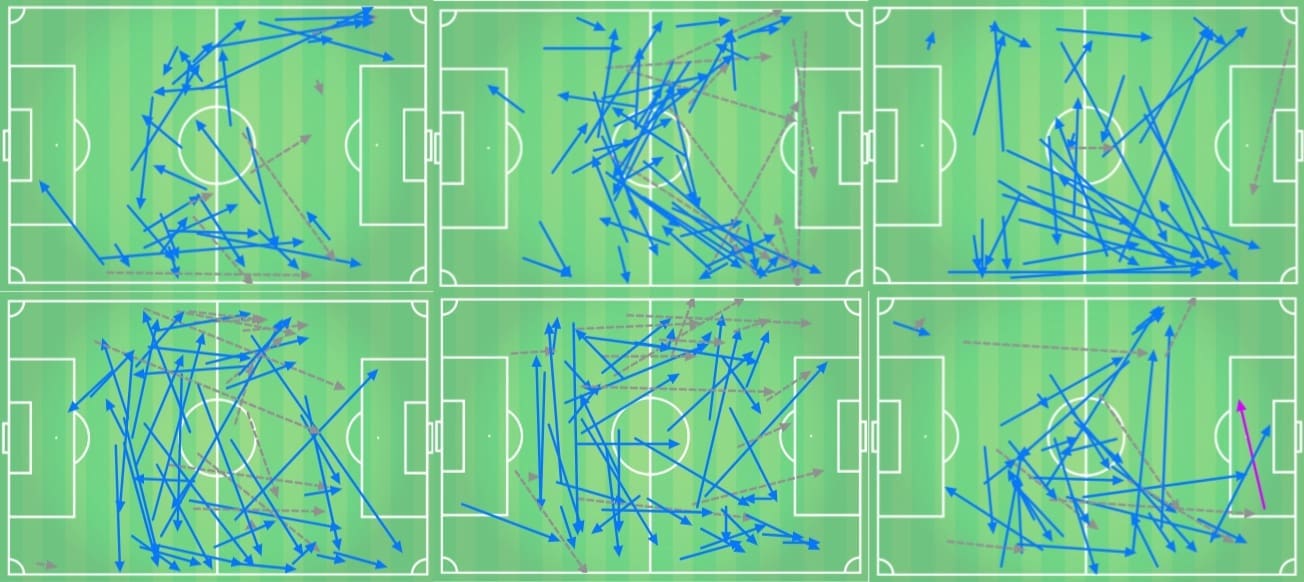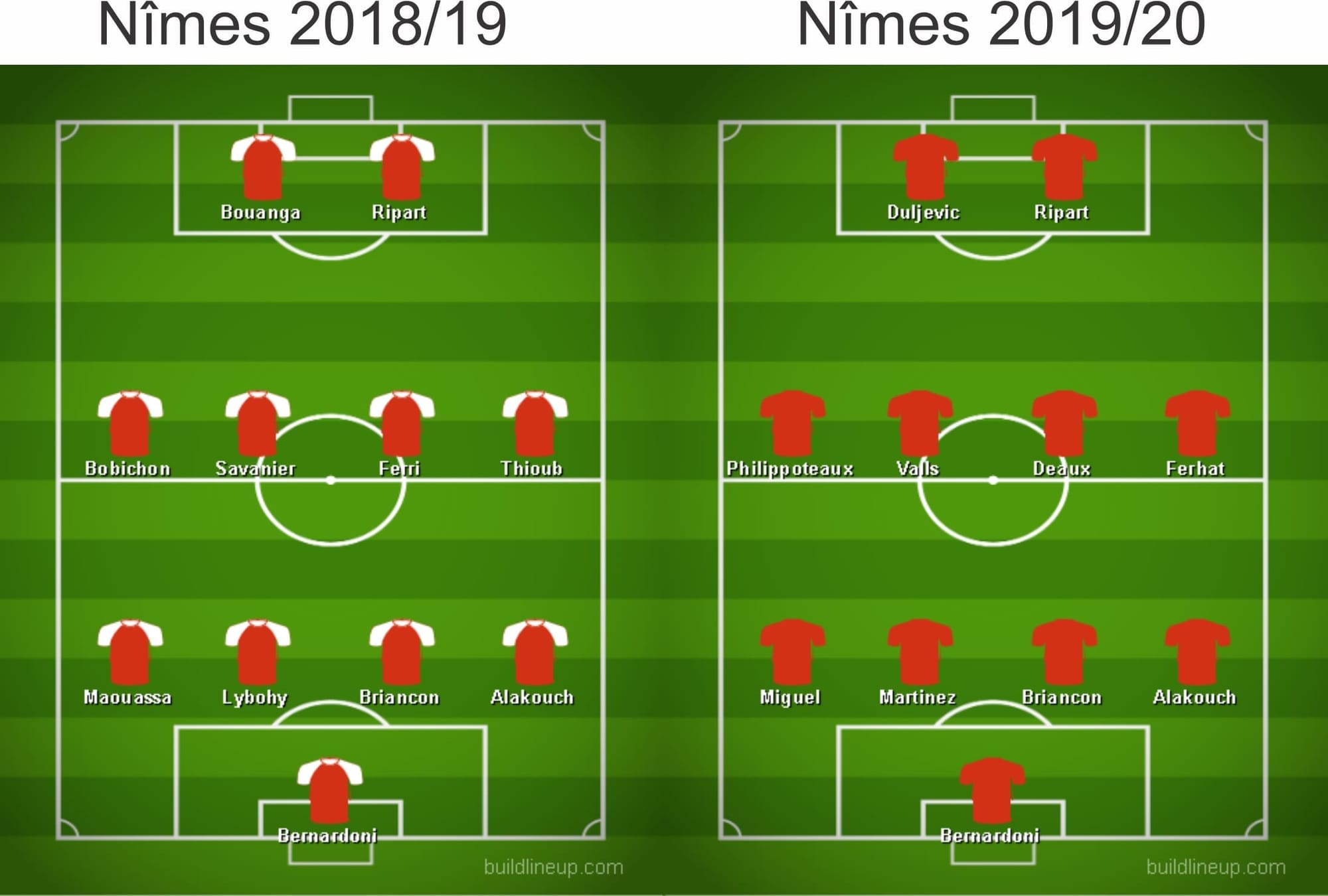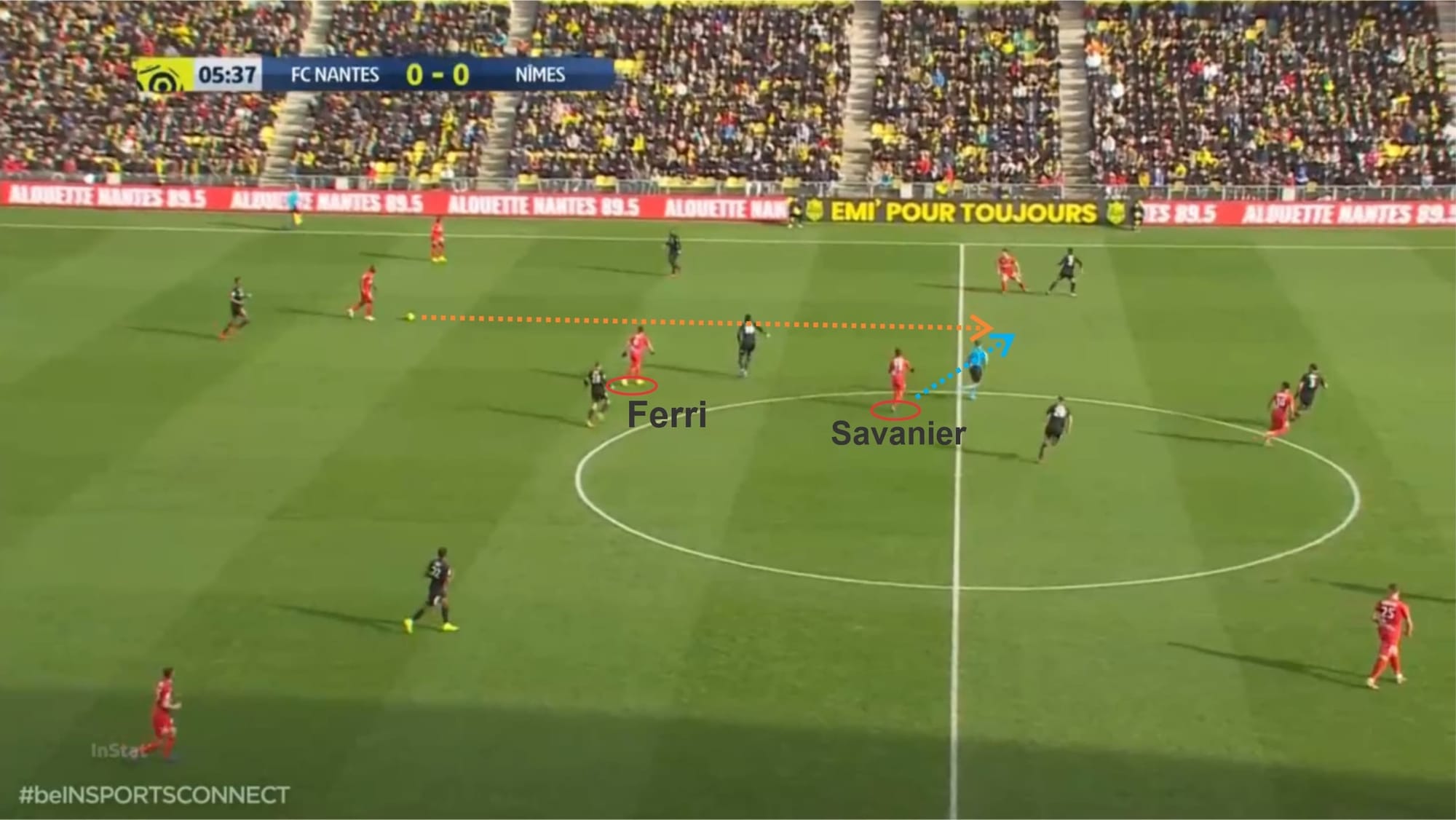19th-placed with only three wins from 20 games and 15 points, Nîmes are not currently in a position of comfort in Ligue 1. Despite managing to force themselves into the mid-table of Ligue 1 in their first season after getting promoted last season, Nîmes haven’t been able to replicate the same success in 2019/20.
Bernard Blaquart’s side have lost their pillars but are they really what caused Nîmes’ current struggles?
In this tactical analysis/scout report, we’re going to take a closer look at why Nîmes are having a disastrous campaign in Ligue 1 this season.
Summer transfer analysis
Nîmes lost most of their key players from the previous season this summer. Wide playmaker Antonin Bobichon and athletic winger Sada Thioub both signed for league rivals Angers alongside Rachid Alioui.
Denis Bouanga, who was one of the most prolific players at Nîmes last season, left for Saint-Étienne. Meanwhile, Téji Savanier – who finished the season as the top assist provider in Ligue 1 – left for a decent fee for Montpellier after a fantastic season with Nîmes.
Jordan Ferri also proved to be a rather important figure in the side. The Lyon loanee provided stability in the midfield, allowing Savanier to unleash his creativity in and around the middle and final third of the pitch.
Nîmes did manage to bring in several replacements over the course of the summer, but are they really the players they needed this season?
Nîmes brought in Lamine Fomba, Sidy Sarr, Haris Duljevic, Lucas Deaux, Romain Philippoteaux, Pablo Martinez, Zinedine Ferhat, and Vlatko Stojanovski this summer.
Ferhat looked to be a rather similar player to Bobichon, a wide player with very good playmaking ability. Though Bobichon was mainly played as an ‘8’ last season, he also got a decent amount of time playing as a wide midfielder, mainly on the left side. Ferhat can also play centrally though he’s mainly a wide midfielder. Both players aren’t exactly very explosive and pacey but both have very good eyes for a pass and excellent technique on the ball.
Ferhat certainly hasn’t been a disappointment this season. In fact, he’s the opposite. The 26-year-old midfielder has registered a total of one goal and four assists in 20 matches in all competitions this season which is not bad. Ferhat also averages 2.5 key passes per game this season with a 55% success rate. It’s safe to say that Nîmes have found a good Bobichon replacement in Ferhat.
Meanwhile, Duljevic looked quite likely to be a Thioub replacement. Both are highly athletic players with very good pace over long-range and great dribbling skills, quite suitable for a team that rely mainly on quick breaks and counter-attacks like Nîmes. However, so far the former Dynamo Dresden man mostly played as a centre-forward, pairing with Renaud Ripart upfront.
The Bosnian forward has been average at best so far at Nîmes though. He has been okay. He’s fairly creative with decent attacking output, but “okay” certainly won’t be enough to take Nîmes to a higher level. Duljevic looks to be quite suitable for Nîmes when it comes to his style of play but he doesn’t seem good enough for the current level of football.
Nîmes also brought in a technical dribbler in Philippoteaux. The right-footed left-winger has proven to be a pretty decent signing so far. He’s certainly not an upgrade to Bouanga though. While the latter was much more clinical in front of goal last season, Philippoteaux is just simply not as good when it comes to finishing chances.
Philippoteaux is also trailing when it comes to creating chances compared to Bouanga last season. This season, Philippoteaux registers an average of 0.83 key passes per game while creating an average of 0.43 chances per game. Bouanga, meanwhile, averaged 1.3 key passes per game last season whilst also creating 1.2 goalscoring chances per game.
Both players have some similarities in their styles. Both like to drive inside and beat defenders in the box before executing their next action (cross the ball or take a shot). Both are very good dribblers with close control of the ball. And both are explosive over a short distance, however, while Bouanga is also quick over long-range, Philippoteaux seems to have pretty limited top speed which doesn’t make him as quick as Bouanga over longer distance.
Lack of Savanier (creativity) in the midfield
Losing most of their key players certainly affected Nîmes quite a lot this season, but there’s one particular player whose departure is truly missed. Savanier was Nîmes’ best chance creator last season and he proved himself extremely vital in Blaquart’s side, scoring six goals and providing 14 assists.
Savanier was an outstanding advanced playmaker, although it’s also not rare to see him being deployed in a deeper position last season. However, he liked to get forward a lot, sitting around the middle and final third and even roaming wide occasionally.
The 28-year-old midfielder’s playmaking ability was extremely crucial to Nîmes’ game. He’d often sit in the half-space when the ball was on the flank to offer an exit option if the ball-carrier was trapped and once he received the ball, he’d utilise his excellent passing ability to switch the play towards the other flank.

His ability to play the ball forward accurately would be sorely missed as well. Savanier recorded an average of 20 progressive passes with a 68% success rate last season. No current Nîmes player has been able to replicate the same numbers this season. Deaux is currently quite close with 16 progressive passes per game on average with a 70% success rate, but he’s definitely nothing like Savanier. Savanier also averaged around 1.92 key passes per game last season and no current Nîmes defensive/central midfielder has the same tally this season.
Not only a proficient distributor, but Savanier was also a press-resistant midfielder who can also drive forward with the ball due to his excellent ball control and dribbling skills. Savanier registered an average of 10 attacking challenges last season and completed 61% of them per game. His proficiency in dribbling can also be seen through his stats as he attempted an average of six dribbles per game with a 70% success rate. Savanier also averaged around 1.65 progressive runs per game last season.
Nîmes did bring in several defensive/central midfielders in the summer in Fomba, Sarr, and Deaux. Strangely enough, none of the three players really fit into the kind of profile they needed to replace Savanier.
Fomba is a talented box-to-box midfielder with decent distribution and the ability to carry the ball forward, but he’s not actually a proficient chance creator.
Deaux, meanwhile, is excellent when it comes to destroying opposition attacks, winning the ball, and giving it to a more creative player upfront. He too is not a creative outlet. If anything, Deaux looks to be a player suitable in filling in the boots of Ferri who also played in the same role last season.
Sarr, meanwhile, is only a sporadic player. He’s also a good battler in the midfield, but not the same profile compared to Savanier.
Another central midfielder who’s currently getting a decent amount of game time is Théo Valls. Valls is a pretty decent playmaker who usually makes himself available as the first pass in the midfield and distributes the ball forward towards more creative players. A bit more like a deep-lying playmaker rather than an advanced playmaker like Savanier.
This season, Deaux and Valls are the most common central midfield pair but with no Savanier-like figure in the team, how will Blaquart set his tactics? We’ll discuss more about that in the tactical analysis below.
Similar style of play but not quite the same – tactical analysis
In terms of tactics, there don’t seem to be a lot of changes that can be seen when comparing the current and previous season. With Blaquart still in charge, Nîmes still play with similar style although there are, of course, some changes of personnel.

Above you can see that Blaquart still preferred to use 4-4-2 as his main formation.

Above you can see the most common lineups from the 2018/19 season and 2019/20 season. As mentioned before in this tactical analysis, Deaux and Ferri are both quite similar and this season, Deaux is playing in a similar role to Ferri last season at Nîmes. But the loss of Savanier and the presence of Valls means that there will be a certain difference when they’re playing although this difference doesn’t significantly affect the main tactical idea.

Above, for example, was a commonly occurring movement and positioning from the two central midfielders. The two central midfielders were quite fluid and both always look to actively move and look for pockets of spaces in central areas. Usually, one central midfielder would stay close to the ball-carrier and stay central while the other one gets into a more advanced position and exploit that space. In the picture above Savanier looked to exploit the pocket of space in the half-space while Ferri occupied the six space. The positioning was quite fluid and Savanier and Ferri would often switch roles.

The same thing can still be seen this season. As you can see in the picture above, Deaux occupies the half-space and gets into a more advanced position while Valls stays central and occupies the six space. This fluid central midfielder positioning helps Nîmes create overloads in certain areas of the pitch (especially half-spaces and flanks).
However, despite the same tactical tendency, Deaux and Valls are both not quite as good when it comes to retaining the ball in tight spaces and releasing a defence-cutting through pass as Savanier.
There’s some evidence to this as well when you look at the stats. Deaux and Valls register an average of six and 5.5 with success rates of 50% and 58% respectively. These numbers are pretty decent, but not quite as good as Savanier who managed to record an average of 10 attacking challenges last season with a higher success rate of 61%.
Deaux and Valls also only average 0.53 and 0.75 key passes per game respectively. This is quite contrasting to Savanier who singlehandedly averaged 1.92 key passes per game last season.
This shows that despite a similar tactical idea and tendency in the game, last season’s Nîmes and this season’s Nîmes are not quite the same. This, of course, also proves how important the presence of Savanier is in the team and how Nîmes really need a similar profile this season.
Conclusion
Concluding this tactical analysis/scout report, losing their key players really hurt Nîmes this season, but they could have lessened the effect with proper recruitment. Unfortunately, Nimes seemed to have failed in this department. This can be especially seen as they failed to get a proper replacement of Savanier, who was extremely vital when it comes to progressing ball, linking play, and even creating chances last season.
There’s not a lot of changes when it comes to the style of play. Blaquart still employed pretty much the same system with the same tactics albeit with different players in certain positions. However, similar problems still persist.
Nîmes have everything still to fight for this season. If they can get back to winning ways, they could escape the relegation zone. At the moment, Nîmes are only six points adrift from safety. Whether or not they’ll be able to stay in Ligue 1 next season, we shall see.





Comments